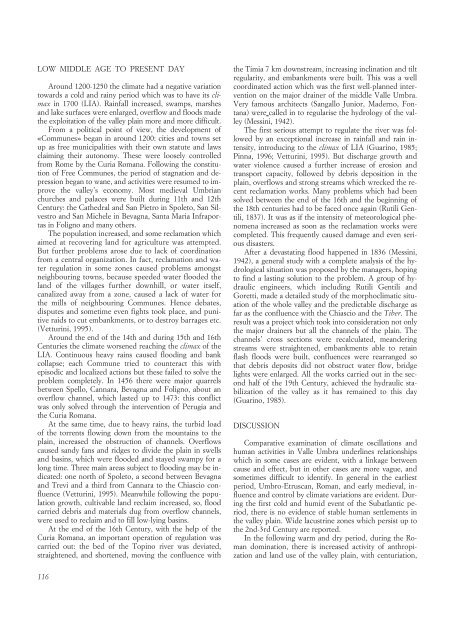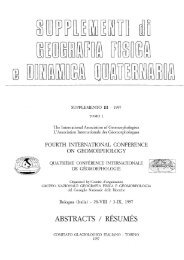Full Text (PDF)
Full Text (PDF)
Full Text (PDF)
You also want an ePaper? Increase the reach of your titles
YUMPU automatically turns print PDFs into web optimized ePapers that Google loves.
LOW MIDDLE AGE TO PRESENT DAY<br />
Around 1200-1250 the climate had a negative variation<br />
towards a cold and rainy period which was to have its climax<br />
in 1700 (LIA). Rainfall increased, swamps, marshes<br />
and lake surfaces were enlarged, overflow and floods made<br />
the exploitation of the valley plain more and more difficult.<br />
From a political point of view, the development of<br />
«Communes» began in around 1200: cities and towns set<br />
up as free municipalities with their own statute and laws<br />
claiming their autonomy. These were loosely controlled<br />
from Rome by the Curia Romana. Following the constitution<br />
of Free Communes, the period of stagnation and depression<br />
began to wane, and activities were resumed to improve<br />
the valley’s economy. Most medieval Umbrian<br />
churches and palaces were built during 11th and 12th<br />
Century: the Cathedral and San Pietro in Spoleto, San Silvestro<br />
and San Michele in Bevagna, Santa Maria Infraportas<br />
in Foligno and many others.<br />
The population increased, and some reclamation which<br />
aimed at recovering land for agriculture was attempted.<br />
But further problems arose due to lack of coordination<br />
from a central organization. In fact, reclamation and water<br />
regulation in some zones caused problems amongst<br />
neighbouring towns, because speeded water flooded the<br />
land of the villages further downhill, or water itself,<br />
canalized away from a zone, caused a lack of water for<br />
the mills of neighbouring Communes. Hence debates,<br />
disputes and sometime even fights took place, and punitive<br />
raids to cut embankments, or to destroy barrages etc.<br />
(Vetturini, 1995).<br />
Around the end of the 14th and during 15th and 16th<br />
Centuries the climate worsened reaching the climax of the<br />
LIA. Continuous heavy rains caused flooding and bank<br />
collapse; each Commune tried to counteract this with<br />
episodic and localized actions but these failed to solve the<br />
problem completely. In 1456 there were major quarrels<br />
between Spello, Cannara, Bevagna and Foligno, about an<br />
overflow channel, which lasted up to 1473: this conflict<br />
was only solved through the intervention of Perugia and<br />
the Curia Romana.<br />
At the same time, due to heavy rains, the turbid load<br />
of the torrents flowing down from the mountains to the<br />
plain, increased the obstruction of channels. Overflows<br />
caused sandy fans and ridges to divide the plain in swells<br />
and basins, which were flooded and stayed swampy for a<br />
long time. Three main areas subject to flooding may be indicated:<br />
one north of Spoleto, a second between Bevagna<br />
and Trevi and a third from Cannara to the Chiascio confluence<br />
(Vetturini, 1995). Meanwhile following the population<br />
growth, cultivable land reclaim increased, so, flood<br />
carried debris and materials dug from overflow channels,<br />
were used to reclaim and to fill low-lying basins.<br />
At the end of the 16th Century, with the help of the<br />
Curia Romana, an important operation of regulation was<br />
carried out: the bed of the Topino river was deviated,<br />
straightened, and shortened, moving the confluence with<br />
116<br />
the Timia 7 km downstream, increasing inclination and tilt<br />
regularity, and embankments were built. This was a well<br />
coordinated action which was the first well-planned intervention<br />
on the major drainer of the middle Valle Umbra.<br />
Very famous architects (Sangallo Junior, Maderno, Fontana)<br />
were called in to regularise the hydrology of the valley<br />
(Messini, 1942).<br />
The first serious attempt to regulate the river was followed<br />
by an exceptional increase in rainfall and rain intensity,<br />
introducing to the climax of LIA (Guarino, 1985;<br />
Pinna, 1996; Vetturini, 1995). But discharge growth and<br />
water violence caused a further increase of erosion and<br />
transport capacity, followed by debris deposition in the<br />
plain, overflows and strong streams which wrecked the recent<br />
reclamation works. Many problems which had been<br />
solved between the end of the 16th and the beginning of<br />
the 18th centuries had to be faced once again (Rutili Gentili,<br />
1837). It was as if the intensity of meteorological phenomena<br />
increased as soon as the reclamation works were<br />
completed. This frequently caused damage and even serious<br />
disasters.<br />
After a devastating flood happened in 1836 (Messini,<br />
1942), a general study with a complete analysis of the hydrological<br />
situation was proposed by the managers, hoping<br />
to find a lasting solution to the problem. A group of hydraulic<br />
engineers, which including Rutili Gentili and<br />
Goretti, made a detailed study of the morphoclimatic situation<br />
of the whole valley and the predictable discharge as<br />
far as the confluence with the Chiascio and the Tiber. The<br />
result was a project which took into consideration not only<br />
the major drainers but all the channels of the plain. The<br />
channels’ cross sections were recalculated, meandering<br />
streams were straightened, embankments able to retain<br />
flash floods were built, confluences were rearranged so<br />
that debris deposits did not obstruct water flow, bridge<br />
lights were enlarged. All the works carried out in the second<br />
half of the 19th Century, achieved the hydraulic stabilization<br />
of the valley as it has remained to this day<br />
(Guarino, 1985).<br />
DISCUSSION<br />
Comparative examination of climate oscillations and<br />
human activities in Valle Umbra underlines relationships<br />
which in some cases are evident, with a linkage between<br />
cause and effect, but in other cases are more vague, and<br />
sometimes difficult to identify. In general in the earliest<br />
period, Umbro-Etruscan, Roman, and early medieval, influence<br />
and control by climate variations are evident. During<br />
the first cold and humid event of the Subatlantic period,<br />
there is no evidence of stable human settlements in<br />
the valley plain. Wide lacustrine zones which persist up to<br />
the 2nd-3rd Century are reported.<br />
In the following warm and dry period, during the Roman<br />
domination, there is increased activity of anthropization<br />
and land use of the valley plain, with centuriation,















